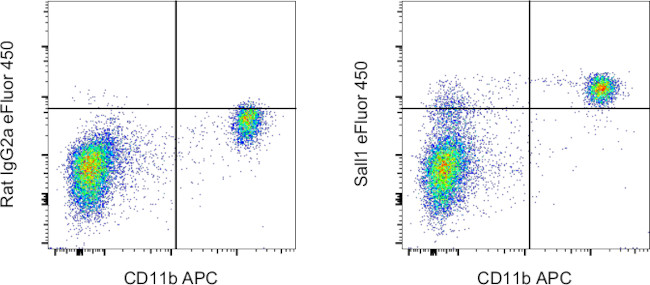Search Thermo Fisher Scientific
Invitrogen
Sall1 Monoclonal Antibody (NRNSTNX), eFluor™ 450, eBioscience™
This Antibody was verified by Relative expression to ensure that the antibody binds to the antigen stated.
FIGURE: 1 / 2
Sall1 Antibody (48-9729-82) in Flow


Product Details
48-9729-82
Species Reactivity
Host/Isotype
Recommended Isotype Control
Class
Type
Clone
Immunogen
Conjugate
Excitation/Emission Max
Form
Concentration
Purification
Storage buffer
Contains
Storage conditions
Shipping conditions
RRID
Product Specific Information
Description: This NRNSTNX monoclonal antibody recognizes mouse Sall1.
Applications Reported: This NRNSTNX antibody has been reported for use in intracellular staining followed by flow cytometric analysis.
Applications Tested: This NRNSTNX antibody has been tested by intracellular staining followed by flow cytometric analysis of mouse brain cells using the Intracellular Fixation & Permeabilization Buffer Set (Product # 88-8824-00) and protocol. Please refer to "Staining Intracellular Antigens for Flow Cytometry, Protocol A: Two step protocol for intracellular (cytoplasmic) proteins" located at Flow Protocols . This may be used at less than or equal to 1.0 µg per test. A test is defined as the amount (µg) of antibody that will stain a cell sample in a final volume of 100 µL. Cell number should be determined empirically but can range from 10^5 to 10^8 cells/test. It is recommended that the antibody be carefully titrated for optimal performance in the assay of interest.
eFluor 450 is an alternative to Pacific Blue. eFluor 450 emits at 446 nm and is excited with the violet laser line (405 nm). Please make sure that your instrument is capable of detecting this fluorochrome.
Excitation: 405 nm; Emission: 445 nm; Laser: Violet Laser.
Target Information
Sall1, which encodes a zinc finger protein, functions as a transcriptional repressor and interacts physically with histone deacetylase and other components of the chromatin remodeling NuRD complex. It is unknown whether the transcriptional repression is solely dependent on histone deacetylase activity. Gene expression profiling has identified Sall1 as a microglial signature gene. Microglia are the resident macrophages of the central nervous system (CNS). Sall1 is also expressed in abundance in the mesenchyme-derived structure from condensed mesenchyme, S-comma-shaped bodies, to renal tubules and podocytes. Sall1 has been identified as a key transcription factor in self-renewal renal progenitor cells. Sall1 is required to maintain the stemness of nephron progenitor cells by restraining their differentiation into renal vesicles. Defects in SALL1 are the cause of Townes-Brocks syndrome as well as bronchio-oto-renal syndrome. Heterozygous mutations of human SALL1 leading to Townes-Brocks syndrome features dysplastic ears, preaxial polydactyly, imperforate anus, and less commonly, kidney and heart anomalies (Kohlhase et al. 1998). Two transcript variants encoding different isoforms have been found for this gene.
For Research Use Only. Not for use in diagnostic procedures. Not for resale without express authorization.
How to use the Panel Builder
Watch the video to learn how to use the Invitrogen Flow Cytometry Panel Builder to build your next flow cytometry panel in 5 easy steps.
References (0)
Bioinformatics
Protein Aliases: sal-3; sal-like protein 1; zinc finger protein Spalt-3
Gene Aliases: Msal-3
Entrez Gene ID: (Mouse) 58198

Performance Guarantee
If an Invitrogen™ antibody doesn't perform as described on our website or datasheet,we'll replace the product at no cost to you, or provide you with a credit for a future purchase.*
Learn more
We're here to help
Get expert recommendations for common problems or connect directly with an on staff expert for technical assistance related to applications, equipment and general product use.
Contact tech support

